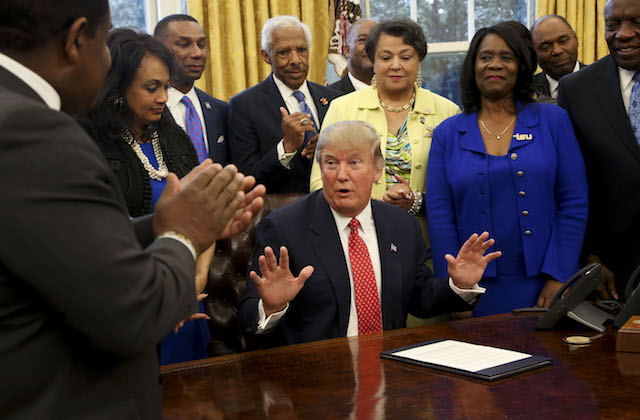President Donald Trump followed up on campaign promises to address historically Black colleges and universities (HBCUs) with a new executive order that has already courted controversy for what it leaves out.
Trump signed the "Presidential Executive Order on The White House Initiative to Promote Excellence and Innovation at Historically Black Colleges and Universities" during an Oval Office ceremony attended by nearly 20 HBCU leaders yesterday (February 28). PBS reports that the order follows talks between Trump, HBCU presidents and Republican lawmakers over the last two days. It was issued the day after Department of Education secretary Betsy DeVos released a controversial statement praising Black colleges as "real pioneers when it comes to school choice"—a policy many education advocates say undermines public school infrastructure at the expense of students of color.
"HBCUs have been really pillars of the African-American community for more than 150 years—amazing job—and a grand and enduring symbol of America at its absolute best," said Trump during the signing ceremony. "With this executive order, we will make HBCUs a priority in the White House—an absolute priority."
The order’s provisions include:
- A new "White House Initiative on HBCUs" that revokes Barack Obama‘s previous HBCU initiative, moving HBCU oversight from the Department of Education the president’s office
- A presidentially appointed advisory board consisting of private and public sector leaders, DeVos and sitting HBCU presidents
"This is a great day for my membership and a great day for America," Lezli Baskerville—president of nonprofit National Association For Equal Opportunity in Education, which represents HBCU leaders—told PBS.
But many critics say the order, which does not specify funding amounts or mention Pell Grant subsidies at all, does not do enough to support HBCUs struggling with funding deficits. In a letter to the education community, Morehouse College president John Wilson Jr. says that what he thought would be a White House discussion about specific federal subsidies was more symbolic than real. "It is not possible to measure the impact of this gesture anytime soon, if ever," he writes.
@MorehousePrez statement on #Trump #HBCU meeting this past week #Morehouse pic.twitter.com/usl2W3cn8H
— C. Carter Polston (@ccarterpolston) March 1, 2017
Dillard University president Walter Kimbrough wrote in a Medium post that Monday’s rushed photo op eliminated his chance to talk to officials about Pell Grant increases that could support students from low-income households. "The Pell Grant should be the equalizer," he wrote. "It serves 36 percent of all students, 62 percent of Black students and over 70 percent [of students] attending HBCUs. But the education as a private good philosophy has severely limited its impact on the neediest families."
Clarise McCants, Color of Change’s senior campaign manager for criminal justice, also reacted to the executive order. "After running an entire campaign on racist threats to Black communities, Trump and his latest billionaire puppet Betsy DeVos are now trying to use Black students as publicity props in their quest to win back our favor," she wrote in an emailed statement. "But our communities will not be fooled. Under his administration, our students could face debilitating setbacks like rising student loans, limited access to public schools and slashed funding to Pell grants. Trump’s brief meeting this week with HBCU leaders might have looked good on Instagram, but his utter failure to acknowledge these very real concerns proves once again that he does not care about Black people."
Howard University student activism group Concerned Students, 1867 created a petition that demands a student-led oversight committee to evaluate distribution of funds to Howard and other schools. "Students are the biggest stakeholders!" reads the petition, which is addressed to President Wayne A. I. Frederick. "Consequently, they should have influence over how and where that money is allocated. That’s why it’s necessary to create a student-led advisory committee: we have to put all stakeholders in charge of funding distribution, that includes students! And when funding comes from a divisive source, it’s important that these stakeholders have a transparent understanding of how they will be affected and have decision-making power to create institutional change."
